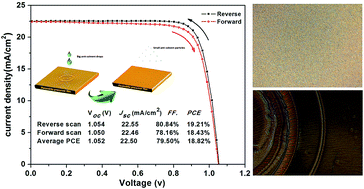Enhanced morphology and stability of high-performance perovskite solar cells with ultra-smooth surface and high fill factor via crystal growth engineering†
Abstract
Since solvent engineering methods were applied to the treatment of perovskite films, the performance of perovskite solar cells (PSCs) has shown rapid growth and remarkable achievements have been made. Here we report a highly reproducible method for controlling perovskite crystal growth by a spraying anti-solvent process, which is quite different from conventional dripping methods. The results showed that the change of the method by which the anti-solvent is used has a significant impact on the morphology and formation of the perovskite. It has a high probability to form a mirror-like surface without wave-circle or ring defects, and to obtain a longer carrier lifetime than crystals formed by by dripping. After optimizing the spraying operating conditions, the optimal device based on FA0.81MA0.15Cs0.025PbI2.5Br0.45 obtained a PCE of 19.21%. Particularly, this method exhibited good reproducibility and a high fill factor due to the reduced crystal defects in the film. The champion cell obtained a fill factor as high as 80.84%, measured at AM 1.5G, 100 mW cm−2. It is expected that these findings can be beneficial for the future integrated applications of these perovskites.



 Please wait while we load your content...
Please wait while we load your content...